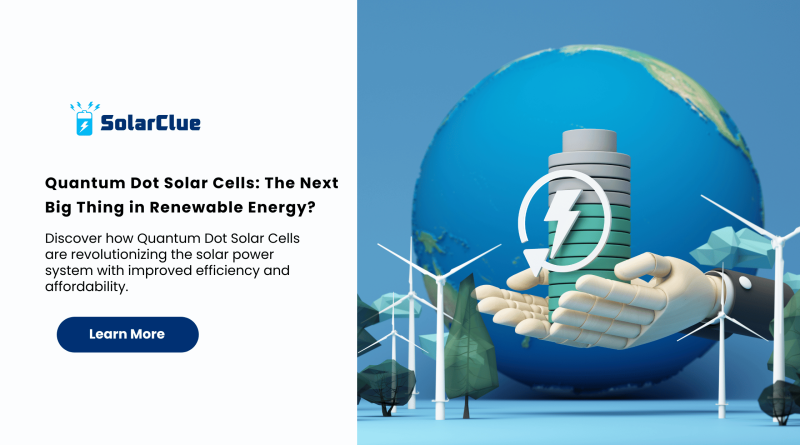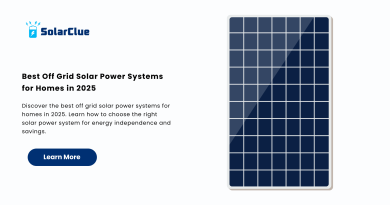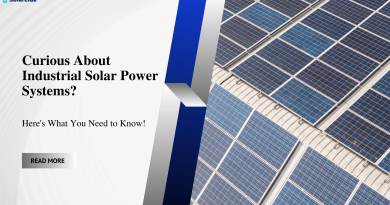Quantum Dot Solar Cells: The Next Big Thing in Renewable Energy?
Solar energy has been at the forefront of the renewable energy revolution. With the growing demand for sustainable and efficient solutions, Quantum Dot Solar Cells have emerged as a game-changer. This cutting-edge technology promises to enhance the efficiency of solar panels, reduce solar cells price, and revolutionize solar cells manufacturing. But what makes them special? Let’s dive into their potential and how they are reshaping the solar power system.
Table of Contents
- 1 What Are Quantum Dot Solar Cells?
- 2 How Do Quantum Dot Solar Cells Work?
- 3 Advantages of Quantum Dot Solar Cells
- 4 The Role of Quantum Dot Solar Cells in Solar Power Systems
- 5 Solar Cells Manufacturing: A Game-Changer for the Industry
- 6 Challenges Facing Quantum Dot Solar Cells
- 7 Future of Quantum Dot Solar Cells
- 8 Final Thoughts: A Bright Future for Solar Energy
- 9 FAQs
- 9.1 1. How are Quantum Dot Solar Cells different from traditional solar cells?
- 9.2 2. Will Quantum Dot Solar Cells reduce the cost of solar power systems?
- 9.3 3. Can Quantum Dot Solar Cells be used for home installations?
- 9.4 4. Are Quantum Dot Solar Cells commercially available?
- 9.5 5. What role does the Ministry of Renewable Energy play in this innovation?
What Are Quantum Dot Solar Cells?
Quantum Dot Solar Cells (QDSCs) are a new generation of solar cells that use nanocrystals, or quantum dots, to capture and convert sunlight into electricity. Unlike traditional solar panels, which rely on silicon, these cells utilize tiny semiconductor particles that offer enhanced light absorption and efficiency.
How Do Quantum Dot Solar Cells Work?
These solar cells operate on the principle of quantum mechanics. The quantum dots, which are only a few nanometers in size, have the unique ability to absorb and convert sunlight across a broader spectrum. This means they can capture more energy compared to conventional solar cells, making them highly efficient.
Advantages of Quantum Dot Solar Cells
1. Higher Efficiency
Traditional solar panels are limited in their ability to absorb sunlight, often wasting a significant portion. Quantum Dot Solar Cells overcome this by harvesting more photons and generating more electricity, boosting overall efficiency.
2. Lower Solar Cells Price
One of the biggest challenges in adopting solar power systems has been the high solar cells price. Quantum Dot Solar Cells use cost-effective materials, reducing solar cells manufacturing expenses, making solar energy more affordable for households and businesses.
3. Lightweight and Flexible
Unlike rigid traditional solar panels, quantum dot technology enables the production of lightweight and flexible solar cells for home installations, making them ideal for roofs, windows, and even portable devices.
4. Improved Low-Light Performance
Quantum dots can efficiently absorb both direct and indirect sunlight, making them more effective even in low-light conditions, unlike conventional solar panels that struggle on cloudy days.
5. Sustainable and Eco-Friendly
With the Ministry of Renewable Energy pushing for cleaner alternatives, Quantum Dot Solar Cells align perfectly with sustainability goals, as they use non-toxic and abundant materials.
The Role of Quantum Dot Solar Cells in Solar Power Systems
The integration of Quantum Dot Solar Cells into existing solar power systems can drastically improve efficiency. This technology allows for multi-junction solar cells, meaning they can stack layers of different quantum dots to capture a wider range of the solar spectrum, leading to higher energy yields.
Solar Cells Manufacturing: A Game-Changer for the Industry
1. Cost-Effective Production
Traditional solar cells manufacturing involves expensive and energy-intensive silicon processing. Quantum dots, however, can be synthesized using simple chemical processes, reducing costs and making production more scalable.
2. Customization & Versatility
Quantum dots can be tuned to absorb specific wavelengths of light, allowing for highly customized solar panels that maximize efficiency based on geographic and climate conditions.
3. Rapid Adoption by the Industry
With increasing investments in renewable energy, major manufacturers are embracing quantum dot technology, paving the way for mass adoption and innovation in solar cells for home and industrial applications.
Challenges Facing Quantum Dot Solar Cells
Despite their potential, Quantum Dot Solar Cells still face some challenges:
1. Stability Issues: Current quantum dot materials degrade over time, reducing longevity compared to silicon-based solar cells.
2. Scaling Up Production: While lab results are promising, mass-producing quantum dot solar panels at a commercial scale remains a challenge.
3. Regulatory Approvals: Governments and organizations like the Ministry of Renewable Energy need to establish standards for their widespread adoption.
Future of Quantum Dot Solar Cells
The future of Quantum Dot Solar Cells looks incredibly promising. Scientists are working on improving their stability and scalability, while industries are pushing towards commercial production. With continued advancements, we can expect:
1. Wider adoption in commercial and residential sectors
2. Enhanced efficiency levels surpassing traditional silicon-based panels
3. Further reduction in solar cells price, making solar energy accessible to all
4. Increased government support from the Ministry of Renewable Energy
Final Thoughts: A Bright Future for Solar Energy
Quantum Dot Solar Cells are set to transform the solar power system, offering better efficiency, affordability, and flexibility. As the industry evolves, this innovation could be the breakthrough needed to make solar cells for home more accessible and practical for everyday use. If you’re considering investing in solar energy, keeping an eye on this emerging technology could be a smart move.
Want to learn more about the latest in solar energy? Visit our website now for exclusive insights and updates!
FAQs
1. How are Quantum Dot Solar Cells different from traditional solar cells?
Quantum Dot Solar Cells use nanotechnology to absorb a broader spectrum of sunlight, making them more efficient than traditional silicon-based solar cells.
2. Will Quantum Dot Solar Cells reduce the cost of solar power systems?
Yes! They use cost-effective materials, which significantly reduces solar cells price and makes solar power systems more affordable.
3. Can Quantum Dot Solar Cells be used for home installations?
Absolutely! Their lightweight and flexible design make them ideal solar cells for home use, integrating seamlessly into various structures.
4. Are Quantum Dot Solar Cells commercially available?
While still in the early stages, major manufacturers are actively working on bringing them to market.
5. What role does the Ministry of Renewable Energy play in this innovation?
The Ministry of Renewable Energy supports the research and development of advanced solar power systems, including Quantum Dot Solar Cells, to promote sustainable energy solutions.




